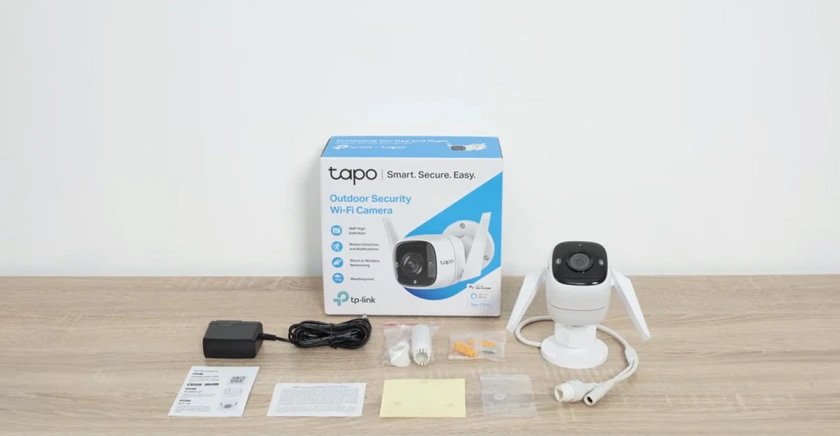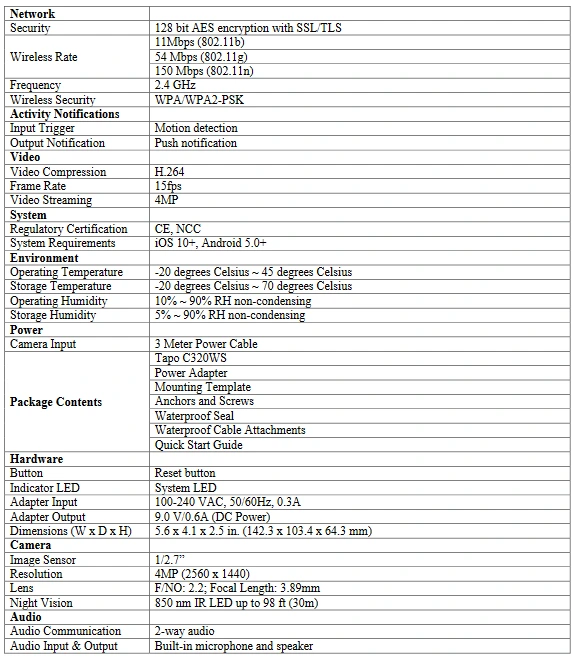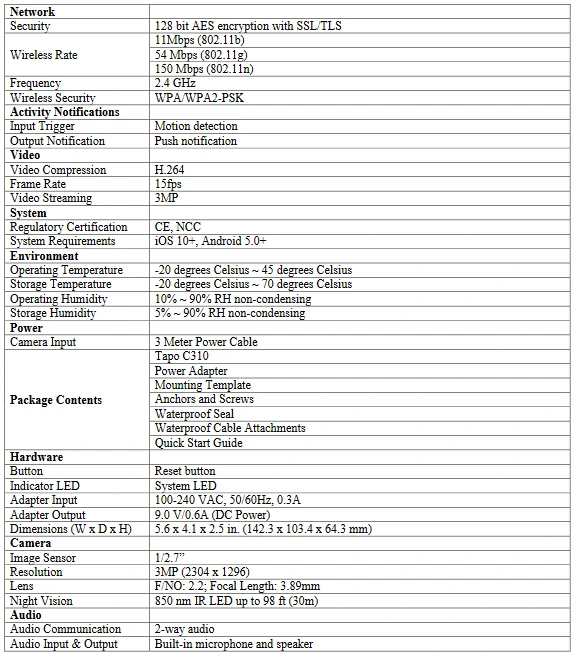
The TP-Link Tapo C320WS camera is an improvement to the TP-Link Tapo C310. This review is a detailed comparison between the two, with the aim of enlightenment.
The peace of mind that comes with having a safe living and working environment cannot be overemphasized. Homeowners like to keep a watch on what’s happening in their homes, whether to monitor specific events or to see who is at the door.
TP-Link has evolved beyond manufacturing networking equipment into producing smart home technologies like security cameras, designed to enhance your life security-wise, and also keep your family safe. TP-Link surveillance cameras are excellent security options that can act as a deterrent as well as a recovery tool. For example, burglars avoid homes with visible security cameras because of the fear of being caught in the act. In addition, if a crime happens, security cameras can help gather evidence, ranging from property damage to the possibility of identifying intruders.
The TP-Link Tapo C320WS and TP-Link Tapo C310 security cameras are some of the company’s top-rated IP cameras to date. They have excellent features and are 4MP and 3MP cameras respectively. Additionally, both cameras are budget-friendly and affordable. However, regardless of their affordability, the big questions are, between the TP-Link Tapo C320WS and the TP-Link Tapo C310, which one satisfies your requirements for ideal surveillance cameras? Is the upgraded TP-Link Tapo C320WS more suited for you than the TP-Link Tapo C310? This review is meant to shed more light on the features, benefits, and drawbacks of using these security cameras in order to help you make an informed decision.
Let’s get started!

Overview of the TP-Link Tapo C320WS and TP-Link Tapo C310
The TP-Link Tapo C320WS camera has many useful features. It is centered on a 4-megapixel resolution at 2560 x 1440, which can effectively capture vital information required to identify people, garments, and activities from a great distance. The front of the camera features five LEDs, two of which are infrared LEDs, another two LEDs for spotlighting, and the last LED displays the camera’s status.
The TP-Link Tapo C320WS relies entirely on the sensor when there is enough light, but as night begins, it switches to its infrared mode and produces black and white images, but on motion detection, it switches automatically to colored view and colored recording.
Additionally, this camera is equipped with artificial intelligence which enables it to detect and alert you to the presence of a human, thereby eliminating false alarms. The camera has an IP66 rating for dust and water resistance; this enables the camera to function optimally regardless of adverse weather conditions.
On the other hand, the TP-Link Tapo C310 comes with a 3 Megapixels resolution, at 2304 x 1296. It can produce high-definition video and clear images sufficient for surveillance requirements. It has infrared LEDs for night vision and can detect movements up to 98 feet (30 meters) away. It also comes with an integrated speaker and microphone, making it suitable for use as a component in a home entry system. The person on the other end of the camera can hear you if you choose to speak, and vice versa. In addition, a siren can be activated to scare away intruders.
The TP-Link Tapo C310 is an IP66-rated outdoor security camera, it can be mounted on a porch ceiling or an exterior wall. If you have a wired network at home or in the office, the TP-Link Tapo C310 and TP-Link Tapo C320WS can connect through an Ethernet cable and Wi-Fi, but they are both not PoE cameras. This means if you have a router capable of PoE, it will not power up any of these cameras, you must power them with the D.C. adapter that comes with them. Both cameras are set up via the TP-Link Tapo app, and this process with the use of the app is quite simple.

Installing the TP-Link Tapo C320WS and TP-Link Tapo C310 IP Cameras
The installation of both devices is a straightforward process that can be carried out by practically anyone with a drill and a dose of common sense, even though some may see it as hard work because of the drilling involved. Truth be told, mounting both devices is not much of a big deal. After skimming through the manual, you are good to go. Both camera packages contain wall-mounting accessories and water-resistant fittings, making installation a walk in the park.
The camera(s) bracket features three adjustable mounting holes in addition to a universal ball joint. It is essential to drill a hole in the exterior wall close to where the camera will be installed in order to create an outlet for power. Then, download the TP-Link Tapo App from the Apple Store or Google Play Store. The app simplifies and streamlines the entire installation procedure. Either camera will be added to your network in seconds once you select them from the available devices, hit the “Add Device” button, and provide your network credentials. As mentioned earlier, both cameras can be connected to a wireless network or wired network depending on your choice.
Specifications of the TP-Link Tapo C320WS Camera

Specifications of the TP-Link Tapo C310 Camera

Night performance of the C320WS camera
The TP-Link Tapo C320WS really shines in low-light conditions thanks to its starlight camera sensor. At night, it functions in both black and white, and in color depending on your settings. The TP-Link Tapo C320WS has a unique function that allows it to glow brightly even in complete darkness, which is its LED spotlights. These LED floodlights have an extraordinarily high output. Moreover, because the floodlights activate automatically when the light level lowers, they complement the starlight image sensor to produce daytime-quality surveillance footage even when it’s dark outside.
How does the C310 perform at night?
The TP-Link Tapo C310 can only produce black-and-white images in total darkness. Therefore, it’s quite clear to see that the TP-Link Tapo C320WS has a significant advantage over the TP-Link Tapo C310 in this area. The image quality at night by the Tapo C320WS is better in terms of brightness than that of the Tapo C310. However, that of the C310 is clear enough for you to see who is hanging around.
Daytime performance/video quality of both cameras
One of the features that make the TP-Link Tapo C320WS outstanding is the video quality it produces. Because it is a 4MP camera, it can capture extremely high-quality footage both in the daytime and at night. Also, you can easily zoom in (8x) to see people and images properly. The improvement in this camera from that of its predecessor is majorly in the image sensor, allowing the camera to shoot images at up to 4MP (2560 x 1440) resolution.
The TP-Link Tapo C310 captures video at 15 frames per second with a resolution of 2304 x 1296. In most lighting conditions, the camera’s image quality is superb. The image and video quality are great during the day, and minute details can be clearly seen. You may also zoom in by double-tapping or pinching. With the TP-Link Tapo C310 camera, you can stream video in three different qualities: 720p for Good Quality, 1080p HD for Better Quality, and 3MP HD for Best Quality. Of course, as the level of quality increases, the necessity for a high-quality internet connection also increases.
Why the TP-Link Tapo C320WS is highly rated
The TP-Link Tapo C320WS is an excellent 2K outdoor security camera with remarkable features such as Line-Crossing Detection, Area Intrusion Detection, Camera Tampering, and Privacy mode. In addition to these, it is a very affordable smart outdoor 2K camera. Its spotlights, siren, AI motion detection, Google Assistant/Amazon Alexa support, two-way audio, color night vision, and support for third-party NVR’s/NAS, make it a great camera you can give a try.
What about the TP-Link Tapo C310?
The TP-Link Tapo C310 is also an excellent 3MP outdoor security camera with UHD video and image quality. It features the same Line-Crossing Detection, Area Intrusion Detection, Camera Tampering, and Privacy Mode as the Tapo C320WS. It doesn’t have spotlights and as such cannot provide colored night vision. It does have a siren, AI motion detection, Google Assistant/Amazon Alexa support, two-way audio, and support for third-party NVR’s/NAS. These make this camera a device you should give a try.
Cons of the TP-Link Tapo C320WS
Despite its high video quality and great night vision capability, the TP-Link Tapo C320WS may not be a top pick for some people for the following reasons:
(1) No PoE
The TP-Link Tapo C320WS comes with an Ethernet cable built with it and carries a LAN port, but it does not support the Power over Ethernet function. This implies that transmission of power and data through an Ethernet cable is not possible. If you have a PoE-supported router, you would still have to use the D.C. power adapter that comes with the camera.
(2) Most features require payment for Cloud Storage
You get a free trial of cloud storage for 30 days and afterwards, you have to pay for this service. This is by far the most significant drawback of the TP-Link Tapo C320WS. As an example, you must have a subscription (Tapo care plan) to use privacy zones. It would have been better if some parts of the cloud storage service were provided for free.
(3) No PC software
There is no provision to have and control your camera via PC software.
(4) No email notifications
Email notifications are unavailable, but if you subscribe to the Tapo care service, you can receive rich notifications with snapshots.
(5) Wi-Fi supports only 2.4GHz
As with most IP cameras and Wi-Fi devices, both 2.4GHz and 5GHz bands are supported, but this is not the case with this camera.
(6) No support for FTP
Cons of the TP-Link Tapo C310
Still wondering why the TP-Link Tapo C310 camera may be a turn-off for some people? Well, the drawbacks are similar to those of the TP-Link Tapo C320WS which are:
(1) No Power over Ethernet functionality.
(2) Most features require payment for cloud storage service.
(3) No PC software.
(4) No email notifications.
(5) Wi-Fi support for only the 2.4GHz band.
(6) No FTP support.
Note: The TP-Link Tapo C320WS supports an SD card of up to 256GB, while the TP-Link Tapo C310 supports an SD card of up to 128 GB.
Conclusion
This review of the TP-Link Tapo C320WS and TP-Link Tapo C310 has shown that they are both great cameras but not without their cons. In recent years, TP-Link has made considerable strides in the development of its surveillance cameras. They are available in both wired and wireless types, and the prices also are significantly lower compared to their competitors.
The TP-Link Tapo C320WS and TP-Link Tapo C310 are capable of providing the satisfactory performance required of a surveillance IP camera. The TP-Link Tapo C320WS is a 4-Megapixel camera, while the TP-Link Tapo C310 is a 3-Megapixel camera. With the TP-Link Tapo C320WS, it is obvious that an outdoor security camera capable of capturing 2K video and offering a wide variety of high-quality functions does not need to be expensive.
However, whichever choice you make, you will surely get a good pick. The cameras have a similar design with integrated support and are waterproof. Both variants support a MicroSD slot, paid cloud storage, 2.4 GHz Wi-Fi, or Ethernet connectivity. To make a purchase of any of these high-tech cameras, see the links below.
You may want to see our review of the TP-Link Tapo C420S2 camera.



Thanks for the fantastic information I was looking for this info for my mission.